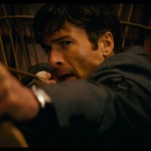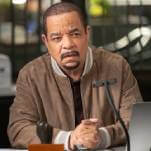With so many new series popping up on streaming services and DVD every day, it gets harder and harder to keep up with new shows, much less the all-time classics. With TV Club 10, we point you toward the 10 episodes that best represent a TV series, classic or modern. If you watch these 10, you’ll have a better idea of what that series was about, without having to watch the whole thing. These are not meant to be the 10 best episodes, but rather the 10 most representative episodes.
Alfred Hitchcock Presents is the other classic anthology series from the early days of television. Polling friends on favorite episodes of the show often reveals answers episodes of The Twilight Zone. The story about the “talking doll“ is often mistakenly associated with Hitchcock, perhaps because it’s so darkly comic and The Twilight Zone rarely did comedy well.
But Hitchcock can claim to be the most successful anthology series in TV history. It ran from 1955 to 1965, longer than any other weekly primetime series in the genre, aside from a few play-of-the-week prestige projects from the earliest days of the medium. It was far more popular than The Twilight Zone, hitting the Nielsen Top 10 in its second season—helped, to be fair, by airing on Sundays, the biggest TV night of the week. That was when it was part of a CBS lineup that included such wholesome programs as Lassie and The Ed Sullivan Show, which makes it all the more impressive that it was one of the nastiest shows to go out over the airwaves in the 1950s.
Alfred Hitchcock Presents is versatile in tone and subject matter, but its most common theme is how rotten seemingly respectable people can be. As Hitchcock explained when welcoming viewers back to the show one autumn, “When crime is occasionally dealt with [on this show], it will be crime as practiced by ordinary people, like the fellow next door. I think that, by spring, a large number of you will be thinking of moving.”
Many episodes are like Breaking Bad in 30 minutes or less, in which sudden greed or wounded pride can lead someone to bump off a spouse, best friend, or random stranger. Sometimes, characters try to rationalize their actions: “Man has the right to help nature along. I mean, if it gets stubborn,” says a wastrel who tries to kill his spinster aunt, by putting ground glass in her food, in “A Perfect Murder.” Other times, they just revel in their villainy: “I consider you and your morality excess baggage!” Darren McGavin’s character spits at his girlfriend when she balks at killing yet another rich old lady in “The Cheney Vase.”
Hitchcock and company got away with this, decades before the rise of the TV anti-hero, for several reasons. First, it was still a big deal for film directors and actors to do television, and Alfred Hitchcock Presents drew top-notch talent, with the first season featuring former Oscar nominees like Claude Rains and Thelma Ritter, and stars like Bette Davis soon to follow. (Hitchcock often showcased former film stars entering their “character actor” phase.) Second, while still making feature films, Hitchcock himself directed over a dozen episodes, almost all of them among the series’ most memorable.
Then there was the slippery point of view in the series. Especially in early episodes, the violence might be off-screen and tongue-in-cheek, making Hitchcock seem no more subversive than a revival of Arsenic And Old Lace. Other episodes are grimmer, but can still be seen as morality tales in which some sinner gets his or her just desserts. The first story of the series, “Revenge,” is a lesson against vigilantism—or, like most episodes, can be enjoyed as a warning that the universe will screw things up and there’s no avoiding that. (After one such tale, Hitchcock reels off a bunch of possible morals and shrugs, “One of them is bound to fit.”)
Some of the episodes are pure malice (the successful framing of someone for a murder, for example), and that’s when it falls to Hitchcock the host to reassure viewers that justice has been done in the end. That’s the legend, anyway. In reality, his concessions toward Standards And Practices are either perfunctory (“Of course, he got caught”) or ludicrous. After one man seems to get away with killing his wife, Hitchcock explains that “his dog… was a detective in disguise and turned him in.”
However, Hitchcock’s hosting duties have uses other than further baffling viewers. (“You needn’t sit there staring,” he says after a Ray Bradbury-related episode. “We’re not going to show you any more. In fact, I’m not even going to tell you what happened.”) His skits saved the screenwriters from having to pad out stories to fit the show’s running time, at least until it was extended to an hour in 1962 and renamed The Alfred Hitchcock Hour. And some of them have a comic surreality that match the best of Ernie Kovacs, such as when Hitchcock attempts to fix viewers’ TV sets from the inside, but only succeeds in shattering the picture tube; or when the silhouette of a woman with an enormous hat takes up most of the TV screen. “Would you mind?” asks Hitchcock, whereupon she takes her entire head off.
The most problematic aspect of the series may be that where The Twilight Zone has mostly original scripts, Alfred Hitchcock Presents generally features adaptations of short stories (including several from Alfred Hitchcock Mystery Magazine, which is still being published). Presumably, some of the stories work better on the page because of the author’s descriptive style or ability to have viewers see things from the point of view of the protagonist. In some cases, there really isn’t a twist at the end of the story, but instead an ironic line.
So the lead performances often determine the quality of a Hitchcock installment. If they don’t work, there’s too much pressure on a surprise ending to save the episode. But if the protagonist is compelling, viewers get a double dose of enjoyment: the fate of the character and the reaction. When a character played by Hitchcock favorite John Williams kills his wife and buries her in the basement in “Back For Christmas,” it’s easy to figure out what’s going to happen, but it’s worth sticking around to see his face in the final shot.
Alfred Hitchcock Presents never tinkered much with its premise of “situation tragedies,” as its host put it, but it gradually evolved in a manner paralleling Hitchcock’s film career. The early seasons lean more on dark comedies recalling Hitchcock’s The Trouble With Harry (1955) or the dry Robert Hamer movie about mass murder with Alec Guinness, Kind Hearts And Coronets (1950). Later, the show’s victims were not as likely to be given the merciful end of a quick blow to the head, and the knives (Eek! Eek! Eek!) came out more often, bringing to mind Hitchcock’s Psycho (1960) and Frenzy (1972).
As with The Twilight Zone, the series lost some steam when it expanded to an hour and had to come up with mini-movies instead of short stories. Both anthology series were revived in the mid-1980s, with the new version of Hitchcock running for four seasons (and including remakes of several episodes from the original run), but never attaining the popularity or critical acclaim of the original.
The fizzled remake strengthened the argument that the anthology series was dead forever. Hopefully someday, a marquee director can bring it back. David Lynch would make a suitably eccentric host, but Steven Soderbergh, now in his TV phase, might be a better judge of story material. The most exciting prospect of all: John Waters Presents.
Until then, here are 10 episodes that demonstrate what only a good anthology series can do:
“Breakdown” (season one, episode seven): A rare foray into the humanist territory of Rod Serling’s Twilight Zone scripts, this Hitchcock-helmed episode stars Joseph Cotten (Uncle Charlie in Shadow Of A Doubt) as a callous businessman who becomes completely paralyzed in a car accident and comes to appreciate the value of expressing emotion. For most of “Breakdown,” he’s unable to speak or move a muscle, and viewers hear his increasingly panicked thoughts (“Why don’t they just feel my pulse?”) as people deal with his “corpse”—including a pair of escaped convicts who steal his clothes. The episode is based on a short story by Louis Pollock that had been published in Collier’s magazine. In 2002, Stephen King updated the basic premise as “Autopsy Room Four,” in a manner that Hitchcock would surely have appreciated.
“You Got To Have Luck” (season one, episode 16): Most Hitchcock villains are expertly played by older actors or woodenly played by newcomers, but this episode stands out for the performance of 26-year-old John Cassavetes as an escaped convict holding a young wife (Marisa Pavan) hostage in her home. His charisma adds an unsettling sexual tension to an otherwise familiar two-character story, something that Hitchcock episodes rarely pulled off (or even tried, given the more censorious times). Plus, the twist here is good enough that it’s possible to forget what it is—even for viewers who’ve seen the episode before.
“One More Mile To Go” (season two, episode 28): David Wayne stars as a man who impulsively kills his wife, stuffs her in his car trunk, and takes a nighttime drive to dispose of the body… if only he had checked his tail light. Hitchcock directs a story with one of his favorite themes, the terror of being tailed by the cops. (Steve Brodie’s cheerfully persistent state trooper is like Columbo without the guile.) In a nice touch, there’s no intelligible dialogue for the first 10 or so minutes of the episode, as viewers see a pantomime of Wayne and his wife fighting from the other side of a window. It’s as if Hitchcock is saying, “Who cares why there’s a murder so long as we get to see one?”
“The Glass Eye” (season three, episode one): Many Hitchcock episodes are about extreme narcissists; this story—told in flashback by William Shatner—is about a pair of lonely outcasts. Julia Lester (Jessica Tandy, the original Blanche Du Bois in A Streetcar Named Desire) is in self-exile from the rest of humanity, living in a tiny apartment and repressing thoughts of romance until she becomes taken with a dapper ventriloquist she sees at a vaudeville show. They share letters, and she becomes convinced that they’re kindred souls. (They’d be quoting lyrics from The Smiths if the tale were set in the 1990s.) But when she finally meets him, things don’t go as expected. Robert Stevens, the most prolific director of the series (44 episodes) won an Emmy for this one. Stirling Silliphant, later an Oscar winner for In The Heat Of The Night, adapted the short story by John Keir Cross.
“Mail Order Prophet” (season three, episode two): In a story that anticipates the plague of email spam, an office drudge named Ronald (E.G. Marshall) gets anonymous letters predicting the outcome of sports games, elections, stock market prices, and just about anything that can be wagered on. The mysterious fortune-teller asks for a just small share of the winnings, and his tips are always right, which confounds Ronald’s skeptical officemate (Jack Klugman). “That’s what’s wrong with you, George. You don’t have any faith,” Ronald says, in a precursor of the long-running arguments on such shows such as The X-Files and House. “You don’t believe in anything.” The climax involves one big bet, and the ending is a clever commentary on the nature of storytelling itself.
“The Perfect Crime” (season three, episode three): A prosecutor who fancies himself the second coming of Sherlock Holmes talks about his career to a visiting lawyer—who argues that Charles Courtney (Vincent Price) has made a grave mistake in one of his most celebrated cases. Not to give away too much, but how often has Vincent Price played a character who responds well to criticism? Directed by Hitchcock and adapted from a 1928s Ben Ray Redman story, this episode includes this profound thought: “It’s funny. You can shoot the heads off all the innocent bottles you like; no one says a word. But if you kill a human snake, they burn you for it.”
“Lamb To The Slaughter” (season three, episode 28): This is the most popularly remembered Hitchcock episode that actually is a Hitchcock episode. Hitchcock directed, and Roald Dahl adapted his own story about a housewife who does in her husband with a frozen leg of lamb. The whacking happens only a few minutes into the episode, and there’s not much in the way of suspense or plot twists after that. What makes “Lamb” so delicious is the lead performance by Barbara Bel Geddes—similar to her plucky, resourceful character in Hitchcock’s Vertigo, filmed almost simultaneously—and the way the audience completely identifies with her as she covers her tracks and deals with the police who are stymied by the absence of a murder weapon. The episode ends with a zoom-in on Bel Geddes’ satisfied face that foreshadows the ending of Hitchcock’s Psycho a few years later.
“Road Hog” (season five, episode 11): The great character actor Robert Emhardt is in the great The Andy Griffith Show episode, “Man In A Hurry,” in which he fumes at, then succumbs to the charms of life in Mayberry. In “Road Hog” (and in another Hitchcock episode, “The Right Kind Of House”), he also plays a loudmouth who stirs up trouble in a small town. This time, viewers know his character is irredeemable, as he first appears stomping on a butterfly that a small girl is admiring, before cackling in her face. His rudeness extends to his driving habits, which turn out to be a contributing factor in a young man’s death. In many Hitchcock episodes, the audience can’t help but root for the protagonist, whether she’s trying to escape a killer or planning to murder her husband. In “Road Hog,” viewers are just hoping that something horrible happens to this guy—and indulging in bloodlust to a greater extent than in just about any other Hitchcock episode. The episode is directed by Stuart Rosenberg, who finally broke into movies with 1967’s Cool Hand Luke.
“The Jar” (season nine, episode 17): Small-town nobody Charlie Hill (Pat Buttram, later Mr. Haney on Green Acres) becomes obsessed with a glass jar and its unidentifiable contents, purchased from a carnival sideshow, in this eerie adaptation of a Ray Bradbury story. He becomes a celebrity as the residents of Wilder’s Hollow come to his living room every night to gaze at the jar and speculate on what’s in it. (A squashed-up octopus? The remains of a missing boy? The source of life itself?) Though, there’s not much urgency to solve the mystery. One old woman pronounces, “More likely, we’ll never find out what it is. And if we do, we might not want to. Won’t have anything to talk about then.” On his own blog, A.V. Club contributor Stephen Bowie notes the similarity between the jar and “the glass box in your living room.” The real trouble starts when Charlie’s two-timing wife threatens to destroy what has become the most important thing in his life. James Bridges was nominated for an Emmy for his teleplay, which justifies the hour-long running time.
“An Unlocked Window” (season 10, episode 17): Hitchcock nears the end of its run with a pure thriller about a serial killer who targets young nurses. (It aired a year before the Richard Speck murders that freaked out everyone on Mad Men.) Two nurses listen to radio reports about the killing spree and try to make it through the night in a secluded house with their invalid patient (and an increasingly drunk and hysterical housekeeper), unaware of that one little security lapse in the title. The episode is more efficient than stylish, moving through horror-movie tropes like a howling rainstorm and a jumpy housecat. But it’s enjoyable as a lean predecessor to the slasher films that would proliferate in the 1970s, all the way through to its revelation of the killer’s identity.
And if you like those, here are 10 more: “Revenge” (season one, episode one); “The Case Of Mr. Pelham” (season one, episode 10); “Alibi Me” (season two, episode seven); “Crack Of Doom” (season two, episode nine); “The Festive Season” (season three, episode 31); “Mrs. Herman And Mrs. Fenimore” (season four, episode 12); “Man From The South” (season five, episode 15); “The Ikon Of Elijah” (season five, episode 16); “Mrs. Bixby And The Colonel’s Coat” (season six, episode one); “Victim Four” (season seven, episode 32).
Availability: The first five seasons are available on DVD. At least the first two seasons can be viewed through Netflix, Amazon, iTunes, and Hulu. Just about all of the episodes, including those in the hour-long format, can be found on YouTube.
Next time: Checking out The Fugitive—just in time for its 50th anniversary.








































